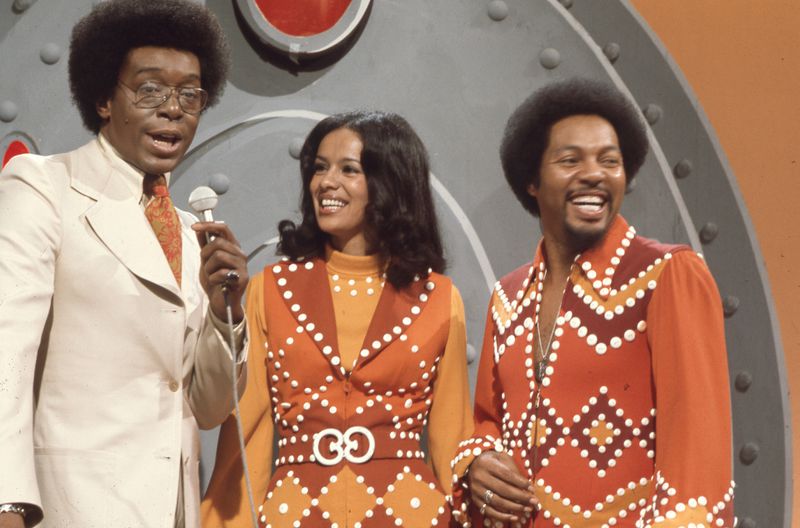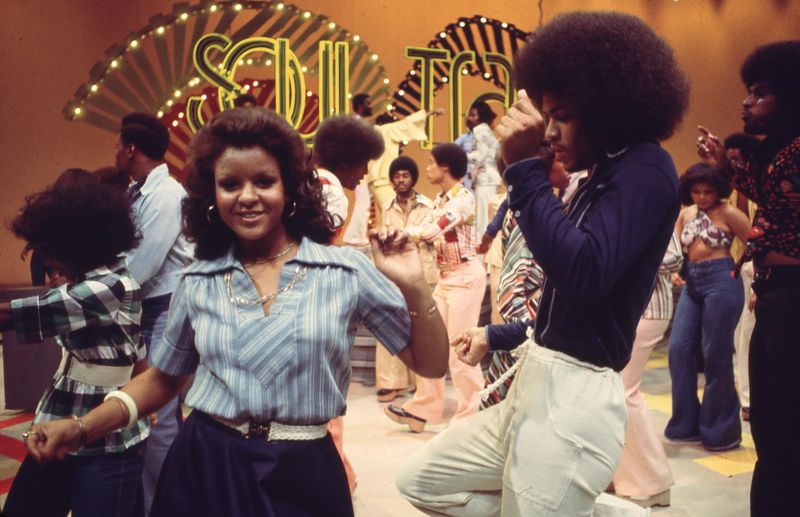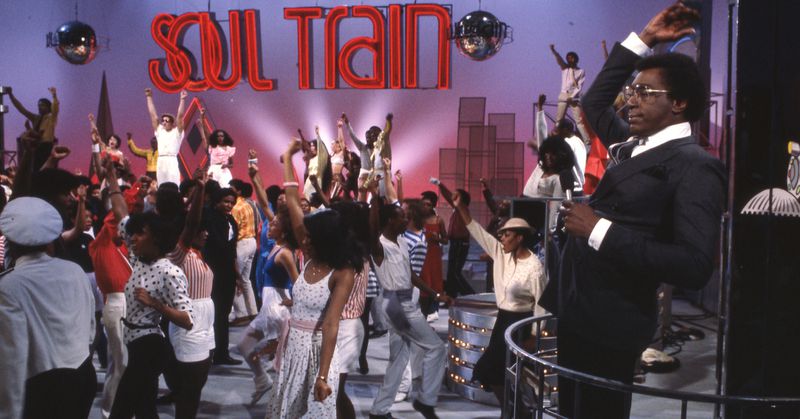
Black creativity found a home on Soul Train — and made TV history.
For 35 years, Soul Train was the beating heart of Black pop culture in America, considered appointment television for the millions of people who tuned in to discover the latest trends in music, dance, and fashion. In its more than 900 episodes, it launched musicians like Teena Marie, Curtis Mayfield, and the Jackson Five, and others like Vivica A. Fox, Jody Watley, and Rosie Perez, to new heights of fame. Now, 54 years after the groundbreaking show’s premiere, its impact on culture and history hasn’t diminished.

Afro American Newspapers/Gado/Getty Images
Soul Train was an ensemble show, featuring musicians, dancers, comedians, and special guests who came together to put on a grand show. It was glittery and glamorous, but also intimate and personal, with celebrities like Patti LaBelle, Elton John, and Little Richard mingling with the dancers in the audience. Simply put, you couldn’t miss it. Richard Gay, the producer of a soon-to-be-on-Broadway musical called Soul Train, tells Vox, “The day Soul Train was supposed to come on, we all knew we needed to have our chores done and everything together so we could watch. ... Then you got older and started tuning in so you could use the dances at the parties that weekend.”
I was too young to really engage with Soul Train during my childhood (and wasn’t even alive during its peak). Still, its legacy lives on for me. From reruns, I can recall with ease the intro, with the animated train, the screech of “The Soullll Trainnn!,” and a smooth voice calling it “the hippest trip in America.” I have vivid memories of Don Cornelius, Soul Train’s founder and legendary “conductor” or host. And the iconic Soul Train line, where people make a corridor and one person has the spotlight, dancing wildly and passionately down the line as everyone claps and cheers, which showed up at so many of my family functions and parties at my alma mater, the historically Black Howard University. It’s undeniable that Soul Train has been a huge part of my life, and that of many others, even long after it stopped airing.

Soul Train via Getty Images
Bethonie Butler, author of Black TV: Five Decades of Groundbreaking Television from Soul Train to Black-ish and Beyond, writes that the variety music program started as a local show on Chicago’s WCIU, a TV station that’s now part of The CW, featuring local musicians like Jerry Butler, the Chi-Lites, and the Emotions. The small local show, often described as the Black version of American Bandstand, an ensemble show that was once only for whites, quickly took off due to the culture’s hunger for the show and its host’s hunger for success. (Don Cornelius’s son said Cornelius wanted to be the “next Black Dick Clark,” the host of American Bandstand.)
“Once people start to hear about it, then the big acts wanted to be a part of it. I know for a fact his initial bookings of the show were not the biggest acts,” Tony Cornelius, Don’s son, told KCRW. “But the biggest acts decided that they wanted to be a part of it and it became the place to be, because everyone started to hear about this phenomenon.”
Its tremendous popularity — it remains the longest first-run syndicated television series in broadcast history — and a key partnership with Johnson Products, the makers of the Afro-Sheen hair care brand, led to its status as a radical show for the times, slotted next to commercials that proudly showcased natural hairstyles like glistening Afros and fluffy tresses in spite of the pressure for Black hair to conform to European standards. Suddenly it wasn’t just Black music or dance on the national stage, but our hair as well.

Soul Train via Getty Images
Black fashion was also a huge part of the show’s success. When people came on Soul Train, they dressed their best. Rich and bright colors, textured fabrics of thick satin and corduroy, dashikis and sequined blazers with shoulder pads and gleaming gold buttons, sharp angles and soft leathers. The fashion was unique and bright, consisting of bell bottoms, exaggerated collars, and flowy blouses. It was a richness of style that felt like seeing the best of ourselves in a time when Black people on TV were often reduced to minstrels — characters that exaggerate negative stereotypes of Black people — or weren’t included at all.
In his 20s, when he was still working for WCIU, Don Cornelius reported on social unrest and met figures like Rev. Jesse Jackson and Rev. Dr. Martin Luther King Jr. Tony Cornelius told KCRW, “My father initially just wanted to do a show that presented Blacks in a positive light, because there was nothing like that going on. I mean, the only thing that you saw about African Americans was on the news where they were being arrested or something.”
Gay, who stood in the lobby after every performance of his musical in the Bay Area, was surprised when Fredrika Newton, the widow of Huey P. Newton, co-founder of the revolutionary Black Panther Party who was murdered in 1989, came up to him to thank him for the nod in the show to the civil rights movement, including the Black Panther Party. “She was almost in tears and she was like, ‘Me and Huey used to watch Soul Train every Saturday. It would bring us joy.’”
Cassie Taylor, a musician whose upbringing was greatly influenced by Soul Train and her father, blues musician Otis Taylor, told me, “Black culture was demonized by the majority of white media, and Soul Train was a place for people to safely express themselves. ... It retains its iconicism because the joy is contagious.” Taylor, who has had a supplemental business from flipping vintage clothing in the past, said her childhood memories of Soul Train informed what she looked for in vintage and thrift shops for her customers.
Entertainers like Bill Withers, Al Green, Bobby Womack, Little Richard, Stevie Wonder, and Marvin Gaye all furthered their careers by appearing on the show. From Soul Train dancer Jeffrey Daniel, Michael Jackson learned the robot and “backslide,” which was renamed the moonwalk, Jackson’s trademark dance. Part of Aretha Franklin’s great fame came from her appearance on the show. After Don Cornelius’s death in 2008, Franklin told ABC that “An appearance on ‘Soul Train’ meant, what it could mean, a person being virtually an unknown person to an American sensation overnight, very similar to ‘American Idol.’” She said, “It was like if you had a record that sold maybe 10,000 copies, to be on ‘Soul Train’ meant it might sell 100 to 200- to 300- or even 500,000 or more.”

Soul Train via Getty Images

Soul Train via Getty Images
Despite — or perhaps because of — its emphasis on joy and togetherness, Soul Train was a response to an incredibly bleak time for Black Americans. When it premiered in 1970 in Chicago, Black Americans like my grandparents were still fleeing racial terror and poverty in the South as part of the Great Migration. Segregation had ended legally, but its disastrous effects were still felt in Black communities everywhere.
Veronica McComb, dean of the College of Arts and Sciences at Bryant University, told me in an interview that “Black bodies were constantly in danger to a high degree. To be in a safe and protected space to express themselves physically in the form of dress and dance was just, as they say, it was everything.”
Soul Train premiered at a time when those who had already migrated were still trying to find community and navigate new racial discrimination in different contexts. “If you’re away from home, like many African Americans were as part of the Great Migration, Soul Train definitely gave you that stronger sense of home,” McComb said. The act of watching became not only a space to gather but a conversation point the next morning at school or work, a way for Black people to find each other in all spaces.
Segregation continued socially, with Black people being chased out of white neighborhoods and schools, while Black neighborhoods and schools remaining overpoliced and underfunded. Lynchings continued, and sundown towns didn’t cease their violence toward Black people. Meanwhile, those who managed to integrate faced their own set of challenges — some of which were intensified. “Integration wasn’t necessarily the wonderful thing that it was intended to be in terms of creating better equity and equality for African Americans,” McComb said. “In some cases, it created a lot of inequity and even more discrimination. ... Soul Train having a space for African Americans was a form of resistance against the forces that would say, ‘You are still not equal; you are still not valued.’ It was a way to say, ‘Yes, we are indeed.’”
For most of its airing, non-Black performers and guests on Soul Train were rare. “It had to be a very particular type of entertainer that was valued by the Black community to be accepted onto Soul Train, because it was such a protected space for Black expression and Black entertainment,” McComb said.
Gay’s Soul Train musical delves into the entrepreneur and visionary Don Cornelius’s biggest project. “He was a kingmaker, right? At the show’s height, you had people like Elton John going, ‘I have this giant audience that knows ‘Crocodile Rock’ that doesn’t look like me. How do I reach them? Well, Soul Train was the answer to that,” said Gay.
On May 17, 1975, Elton John became the first white performer to appear on the show. After that, Soul Train became a sort of litmus test for all musicians but especially white ones. There was a difference between only making music for white people and making music that Black people could jive to as well, a sort of encapsulation of the radicalism of Soul Train. Here, in this integrated space, Black folks made the culture and determined who could cross over into our spaces, an act that truly could transform singers and widen their audience.

Soul Train via Getty Images

Soul Train via Getty Images
It was also a time when popular forms of Black creativity were more accessible. It didn’t cost three months’ rent to see our biggest stars in concert, and spending hundreds on an outfit was unheard of. Pictures of Soul Train from its height show the special environment it cultivated. One in particular shows Marvin Gaye in the crowd, at the audience’s level, smiling and interacting as equals. The fashion was textured, layered, quality, and unique. It was a kind of fashion culture that would be hard to reproduce today because the way we make and consume clothes — in factories with labor exploitation, producing waste that is contributing mightily to the existential climate crisis, and simply making clothes less stylish — has changed radically, for the very worst.
We are in a similar state of despair as the one that Soul Train was born out of. Covid-19 isolated people for months and killed more than a million Americans. Economic instability and student loan debt are crushing people’s hopes for the future. Police brutality is a constant worry for Black people and other marginalized groups. Our court system appears ever more imperiled. We are watching devastating violence take place overseas. This has all taken a tremendous toll on the collective psyche. In the face of such despair, it’s natural that people express a rising dissent against the disappointments of this world, and are actively looking for artistic spaces to express that dissent. “We are in a post-pandemic world and we need a reboot of Soul Train,” Taylor says, adding that the horrors of late-stage capitalism make this more urgent.
Soul Train was revolutionary, but Cornelius was a skilled businessman who went after numbers. Yet Soul Train feels anti-capitalist in some ways in retrospect, not because it was created that way, but because we live in a more flagrantly exploitative and consumerist society than ever before. The show was still revolutionary because of its assertion of Black people’s right to joy and unbridled expression in the face of forces meant to destroy our bodies and souls.
Much of why people loved Soul Train was the intimacy and spontaneity. We live in a time when much of our culture is intensely curated by algorithms and trends, where fast fashion and cosmetic surgeries have produced an eerie sense of sameness, and when public images are more carefully managed than ever before, making it difficult to assess who artists truly are. “Soul Train wasn’t very structured,” said McComb. “There’s an element of spontaneity to the show that just doesn’t exist much anymore. ... There’s this very strong sense of control that exists in American entertainment, broadly speaking, that didn’t exist at the time of Soul Train.”

Soul Train via Getty Images
McComb said that when the spirit of Soul Train truly returns, we likely won’t see it through the same medium. “It may not be on television that we will see protected spaces where people can be their authentic selves. I don’t have much hope for American public entertainment to provide that space,” she said.
She points out that one of the places where this kind of self-expression is seen most often is in spaces that fly under the radar of pop culture. “When people take over warehouses and abandoned buildings and host parties there, that is a means of transgressing and rebelling against the structures and the controls of American capitalism. That’s the closest thing I can think of to Soul Train.”
However, this isn’t necessarily a negative for McComb (although she stresses that she doesn’t endorse the takeover of abandoned buildings). “We’re at a saturation point in American entertainment where there’s just so much messaging and stimuli, that maybe it is the lived experience of that unbridled authenticity that will have a revival.”
The beauty of Soul Train was that “it was the kind of unbridled celebration that you would see in your own home or in your own community, but on American television,” McComb said. For now, then, offscreen, Soul Train lives on in the impromptu line dances we do at weddings, parties, and any function where Black people feel joy and freedom.
----------------------------------------
By: Nylah Burton
Title: The revolutionary spirit of Soul Train
Sourced From: www.vox.com/culture/24080012/soul-train-history-explainer-revolutionary-spirit
Published Date: Sun, 25 Feb 2024 13:00:00 +0000
Did you miss our previous article...
https://consumernewsnetwork.com/politics-us/haleys-nomination-path-is-almost-impossible-because-of-the-real-reasons






